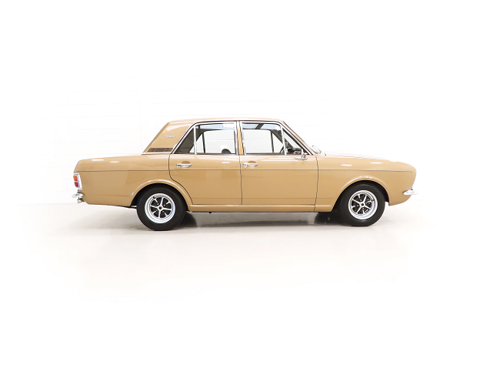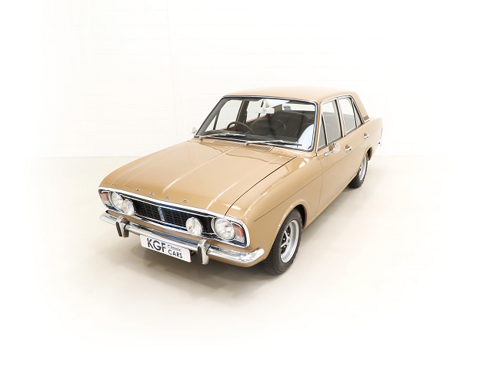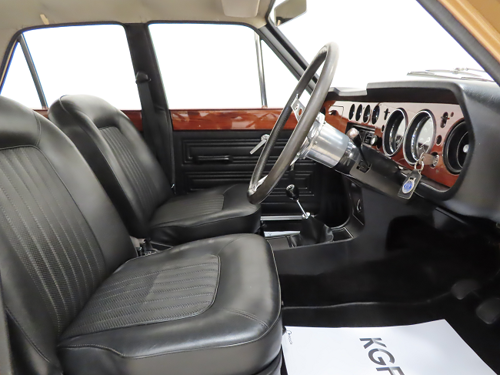LIVING THE 1960S EXECUTIVE DREAM – THE FORD CORTINA 1600E
22 April 2025
The Ford Cortina 1600E (for “Executive”) managed to capture the late 1960s middle-class motoring zeitgeist. The Telegraph thought it suited to “‘fashion-conscious’ motorists”, and this 1969 Amber Gold Series 2 example sold by KGF – https://www.kgfclassiccars.co.uk/ – was perfect for the happening young solicitor with his Jim-Dale-in-Carry On Again Doctor hairstyle. Three Executive Fords predated the 1600E – the 1965 Zodiac Mk. III, the 1966 Zodiac Mk. IV and the 1967 Corsair 2000E – but none had the same marketing and cultural impact as the Cortina. Here are 12 reasons why:
 1) On its debut in late 1967, the 1600E was reasonably priced at £982 2s 1d – £98 more than the price of the GT.
1) On its debut in late 1967, the 1600E was reasonably priced at £982 2s 1d – £98 more than the price of the GT.
2) The 1600E had a 96mph top speed and was genuinely well-appointed: twin Wipac 562 spotlights, a clock, reversing lamps, a cigar lighter, extra sound deadening, dual-tone horns and Ro-Style wheels. Inside, there were reclining front seats, a fascia and door cappings trimmed in polished wood and a leather-covered steering wheel rim.
3) To quote Graham Robson’s fascinating book Cortina: The story of Ford’s Best-seller:
...structurally and mechanically, the 1600E was pure Cortina GT, originally with the lowered and stiffened Lotus-Cortina Mk II suspension settings complete with radius arms, and 5.5in Rostyle wheels. The 1599cc engine was the same as the GT.
4) Ford took less than a month to devise the 1600E and it amounted to just £400 of the PR department’s budget.

5) In 1967 Autocar was confused:
It's hard to see where the Cortina 1600E fits in at only £47 less than a Corsair 2000E, except that there is a very real £1,000 barrier which the Cortina slips under and it has slightly less status attached to it than has a Corsair.
6) There were few domestic rivals. From BMC, the Wolseley 18/85 Landcrab competed against the Corsair 2000E while the MG Magnette Mk. IV and Riley 4/72 Farinas looked about as groovy as Edgar Lustgarten. Nor was there a direct competitor from Triumph or Vauxhall: the 2000 was six-cylinder and far more expensive and the FD-series Victor 2000 was larger and not as well appointed. From the Rootes Group, the similarly sized and even more luxurious Arrow-series Humber Sceptre also debuted in 1967, but was slightly more expensive at £1,047 and had a more middle-aged appeal.
7) By 1968 Autocar seemed far more impressed, one writer noting: “For me the 1600E is quite the nicest Ford for some time, and in a way I envy our advertisement manager who is running one.”
8) That same year, Ford introduced the Series 2 1600E with a modified fascia and rear “bucket seats” with a folding armrest.
9) Motor described the 1600E as an “Enjoyable Extrovert” and John Bolster of Autosport predicted “an enthusiastic demand for the 1600E, the Cortina for the VIP”.

10) Motor Sport complained: "I do not think a wooden interior décor looks right in a modern ‘tin saloon’.” Buyers did not care one iota.
11) The 1600E benefitted from Ford’s superb marketing, including this gem of 1967-vintage sales copy:
You’re driving along in your spanking new Cortina 1600E and your wife starts nagging you so you suggest she reclines her seat and before long she’s dozed off because the 1600E is so quiet and you look at your reflection in the plushy walnut dashboard and think how closely you resemble Gregory Peck and with a roar of the 1600GT engine, you twiddle the aluminium steering wheel and the sculptured racing wheels screech as you take the chicane at 85 and tap tap the man on the Ford stand wakes you up.
12) Graham Robson noted that the 1600E only increased in popularity during its 1967-1970 production run. Many enthusiasts did not regard the Cortina GXL as its true heir – and when Dagenham replaced it with the 2000E in 1973, their advertisements implored: “Now will you please stop writing to us about the old 1600E?”
With thanks to KGF Classic Cars for their time and permission to use the images in this blog.
